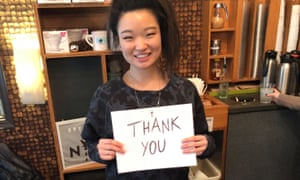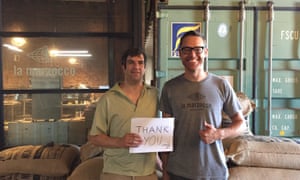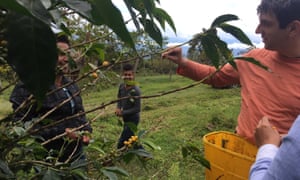Thanks for my coffee… On the great gratitude trail
It’s a Tuesday morning, and I’m in the presence of one of the most mind-boggling accomplishments in human history. This marvel I see before me is the result of thousands of human beings collaborating across dozens of countries. It took the combined labour of chemists, politicians, mechanics, biologists, miners, packagers, smugglers and goatherds. It required aeroplanes, boats, trucks and shoulders and hundreds of materials, including steel and bat guano. It has caused great joy, but also great poverty and oppression. It relied upon ancient wisdom and space-age technology, freezing temperatures and scorching heat, high mountains and deep water. It is my morning cup of coffee.
For most of my life, I rarely thought about my coffee, unless it spilled on my jacket. But the last few months have forced me to change that. A recent study showed that gratitude causes people to be more generous and kinder to strangers. Another study summarised in Scientific American finds that gratitude is the single best predictor of wellbeing and good relationships, beating 24 other impressive traits, such as hope, love and creativity. Earlier this year, in an attempt to battle my default mental state (generalised annoyance and impatience), I undertook a deceptively simple quest. I pledged to thank every single person who made my cup of coffee possible. I resolved to thank the barista, the farmer who grew the beans and all those in between.
For most of my life, I rarely thought about my coffee, unless it spilled on my jacket
I knew the idea was absurd on one level. It’d be a major headache. It’d be time-consuming and travel-heavy. But it might make me more grateful, which would, in turn, make me less petty and annoyed. Because I needed to be less annoyed. I’d estimate that in my default mode, I’m mildly to severely aggravated more than 50% of my waking hours. That’s a ridiculous way to go through life. I don’t want to get to heaven (if such a thing exists) and spend my time complaining about the volume of the harp music.
I decide to do this project in reverse, starting with my local café and working my way backward to the birth of the coffee. And so I set out on the Great Coffee Gratitude Trail…
The barista

FacebookTwitterPinterest ‘It’s not always easy’: Chung the barista, with a talent for customer service
On a Thursday morning I get to the counter and am greeted by my barista, a 20-something woman with hair gathered in a ponytail. She hands me my order – a small black coffee, the daily blend. “Thank you for my coffee,” I say. “You’re welcome!” she says, smiling. And there it is. My first thank you. It’s fine, but no lightning bolts yet.
Her name is Chung. Her parents are Korean immigrants and she grew up in southern California before moving to New York for college. “So…” I say. “What’s it like being a barista?”
“It’s not always easy,” she says. She’s had customers berate her until she cried for mixing up orders. She’s been snapped at by a bratty nine-year-old girl who didn’t like the milk-foam teddy bear that Chung created on top of her hot chocolate. The girl wanted a heart. And yet, Chung says, most folks are friendly, especially when Chung sets the mood by being friendly first. And man, Chung is friendly. She’s like a morning-show host, but not forced or fake. During our half-hour chat, Chung got up no fewer than five times to hug long-time customers. “I first realised I might be good at customer service when I was working as an usher at my church,” she says. “I saw that it takes a certain personality.”
I ask her if she’s planning on being a barista for the long haul. She shakes her head. “Actually, this is my last week.” She’s moving back to California to take care of her parents. Plus, nowadays she’s having trouble staying on her feet her entire shift. “A year and a half ago, I got hit by a bus,” she says. “I broke every toe, the heel, the ankle.” She’ll miss her co-workers, but not the occasional feeling that she doesn’t exist at all. “What’s upsetting is when people treat us like machines, not humans,” Chung says. On my way home, I make a pledge to look baristas in the eyes, because I know I’ve been that asshole who thrusts out the credit card without glancing up. I know I’ve treated many as if they were vending machines.
And this is an enemy of gratitude. University of California psychology professor Robert Emmons – who is considered the father of gratitude research – puts it this way: “Grateful living is possible only when we realise that other people and agents do things for us that we cannot do for ourselves. In gratitude, we recognise that the source of goodness is outside of ourselves.”
The roasters

FacebookTwitterPinterest ‘It can get hot in here’: A.J. Jacobs with Ed Kaufmann of Joe Coffee at a roastery in Brooklyn
Advertisement
As Julie, my wife, gets ready, I look her in the eyes, and say: “I just want to let you know that I am deeply grateful that you took Lucas to the orthodontist yesterday.” “Okaaaay,” she says, pulling on her boots. “You’re deeply welcome, I guess.” Point taken. I sound like a member of a cult who practises nude meditation. But I have a reason. I recently read a Wharton business school study that concluded that people who say the phrase “I am grateful” are seen as more genuinely thankful than when people simply say “Thank you”. The gist of the study is that the phrase “thank you” is too often seen as robotic, a mere verbal reflex. If you switch it up with other gratitude phrases, maybe it will jolt people awake.
Later that morning, I head off to Brooklyn to say “I’m grateful” to some folks at the Joe Coffee roastery. This is the place where the raw green coffee beans are shipped from around the world, cooked dark brown and put into vans to deliver to the cafés.
“It can get hot in here,” Eric explains. Eric is one of a team of five men in charge of loading, weighing and bagging the coffee. “I just want to say I’m grateful to you for helping make my cup of coffee,” I say. “Thanks, man,” Eric responds. “I drink it, too, so I know it can make or break a day.” Each member of the team has his own method for schlepping the 152lb burlap sacks of coffee beans as they come off the trucks, then shovelling them into bags. “I like to finish a bag, fold it up and then go on to the next one,” says Eric’s colleague Lee. “But Eric is the artist. He’ll do three massive scoops in 10 different bags, then finish them all off with a drizzle, so it’s exactly 5lb.”
That weekend we visit our friends in Rhode Island. Ruti is an international relations professor at Providence College. I tell her about Project Gratitude. “Are you serious?” she asks. “You know I just taught a course in the economics of coffee?” I did not know that. Ruti spends the weekend talking to me about the supply chain. “One thing to remember: don’t whitewash the process,” she says. “Some of these plantations are barely better than slave labour.”
I say that I buy from Joe Coffee, a company that seems to have a good social conscience. “That may be true. But just keep in mind there’s a lot of oppression on the path that coffee takes.” Ruti’s right. Coffee causes much good in the world, but it also causes massive suffering. In fact, I’ve been keeping a list of the beverage’s pros and cons on my computer.
On the good side
– Drinking coffee delivers little bursts of dopamine to millions of people every day.
– Coffee is an enormous economic engine for prosperity. – Coffee provides jobs for an estimated 125 million people worldwide.
– In the words of Mark Pendergrast in his book Uncommon Grounds, coffee is “an essential cash crop for struggling family farmers, the basis for national industrialisation and modernisation, and a model of organic production and fair trade.”
On the bad side
Advertisement
– Coffee can wreak havoc on the environment. A group called ClimatePathestimates that 1lb of coffee creates 5lb of carbon dioxide. And that’s not to mention the billions of discarded plastic coffee lids floating in the Pacific. Or how coffee plantations are wiping out forests in Central America.
– Coffee is the stimulant of choice for employers who want to overwork their labourers for an unhealthy number of hours.
– Coffee farming has led to vast wealth imbalances, with a lucky handful making fortunes as millions remain mired in poverty.
I have to confront coffee’s harsh side as well. I don’t want to be so thankful that I start to believe the world is perfect. Which some people argue is the greatest danger of gratitude. Author Barbara Ehrenreich sees gratitude as an opiate of the people. Walmart employees are told to embrace gratitude instead of complain about their low pay. Ehrenreich even hints that the gratitude movement is a right-wing plot. Could it be that I’m simply a dupe? My more cynical side had long thought gratitude likely evolved for selfish reasons, a version of indebtedness, tit for tat: if chimp A picks lice off chimp B, then chimp B is more likely to share food with chimp A.
This is fine as far as it goes; there’s nothing wrong with reciprocity. But new research indicates that gratitude may have outgrown its realpolitik origins. It’s expanded beyond returning favours and boosted our menschiness level toward strangers. My goal for this project is to avoid complacency. Make certain that gratitude is a spark for action, a way to actually improve the lives of the people along the chain even just a tiny bit. How? I don’t have an answer for that yet.
The farmers

FacebookTwitterPinterest ‘Gracisa por ustedes’: picking coffee cherries on the Guarnizo farm
Advertisement
It’s been five months and roughly 700 thank-yous. It’s finally time for my big pilgrimage to the source, the home of the coffee trees. I start by taking a jet down to Bogotá, then a cosy propeller plane to a small city called Neiva, and then into a van for a four-hour ride to an even smaller town called Pitalito. There, I get in the back of a pick-up truck for a 90-minute drive up a curvy mountain road to the coffee farm. I spot the driver doing the sign of the Cross. Several times.
This farm is a small one, owned by the Guarnizo family. The oldest brother, Wilmar, who is squat and broad-shouldered, asks: “Do you want to see the coffee trees?” The trees are about the same height as I am, and covered with little red or yellow fruits that look like grape tomatoes. Wilmar straps a bucket around my shoulders and, as the Guarnizos watch, I pluck a cherry off the tree and drop it in my bucket. At Wilmar’s urging I take a bite. It’s much sweeter than I expected. I ask Wilmar what it’s like to pick cherries all day.
From now on, I’ll think of you when I drink my morning coffee, and perhaps you will think of me
“It’s hard,” he says in Spanish. “The sun, the rain. But it can also be very calm, very quiet.” Let me pause here for a moment to state the obvious: I am lucky. I didn’t pick coffee beans because I had no other job options and needed to earn money to feed my family, which is the situation for thousands of migrant workers. I picked coffee by choice, not necessity.
And how did I arrive at the luxury of having this choice? Well, mostly luck. I’ve been obsessed with luck for many years, and especially with the debate over whether our lives are ruled by randomness, or whether we are the powerful captains of our own fates. If I had to put numbers to it, 20% of my fate has been determined by hard work and persistence, and 80% has been cosmic PowerBall. To a certain extent, you create your own opportunities. But you also need pure luck. And acknowledging the role of chance helps pump up compassion, which is a muscle that I need to work on.
After I pick the fruits, the Guarnizo brothers show me the path of the cherry once it has left the tree, from the de-pulper to a fermenting tub, to a series of mesh screens where they dry. The taste of the coffee can be affected by the amount of rain, the type of soil, the amount of nitrogen fertiliser. Even the shape of the piles when drying can alter the flavour – some farmers put them in rows, others build little pyramids.
After lunch we have coffee that Wilmar’s wife roasted in a saucepan. Now is the time, I tell myself. On the plane ride earlier, I’d scribbled my thoughts in syntax-garbled Spanish. I look at the Guarnizo family, and read: “Gracias por ustedes.” I continue, in my stumbling Spanish, “I now understand more about all the work that goes into making my morning cup of coffee, and I will not take it for granted again. Thank you for picking the beans and washing them and drying them. Your coffee has given me great happiness every morning, and helped give me the energy to write and take care of my kids. From now on, I’ll think of you when I drink my morning coffee. And perhaps you will think of people like me, and the joy you give to us.”
I finish. Silence. Not sure there were actual crickets, but I certainly heard some type of buzzing insects. After a few seconds, I spot Wilmar give just the slightest nod of the head. “Gracias a usted,” he says. I can’t say they were ecstatic or transformed, but I’m pretty sure they didn’t dislike my thank you note. So that’s something.
As we are leaving, there are handshakes. The Guarnizos invite me to come next year and stay longer, maybe a couple of nights. I won’t take them up on the invitation, but I’m grateful to have it.
A week later I’m back in New York, 2,600 miles from the giant chickens and cliffside roads of Colombia and in line for my daily coffee. I tell the barista, “I’m very grateful for my coffee today,” breaking 1,000 thanks. “As well you should be!” he says.
There is a beautiful scene from the book Invisible Cities by Italo Calvino, a fable of a city where people’s apartments are connected by threads. Each thread represents a different kind of relationship. Eventually, the threads grow so numerous and thick and multi-shaded, it’s impossible to walk through the city. If we connected the world with threads signifying gratitude, I realise, taking a sip of my coffee, the result would be as thick as a blanket.

Post a Comment